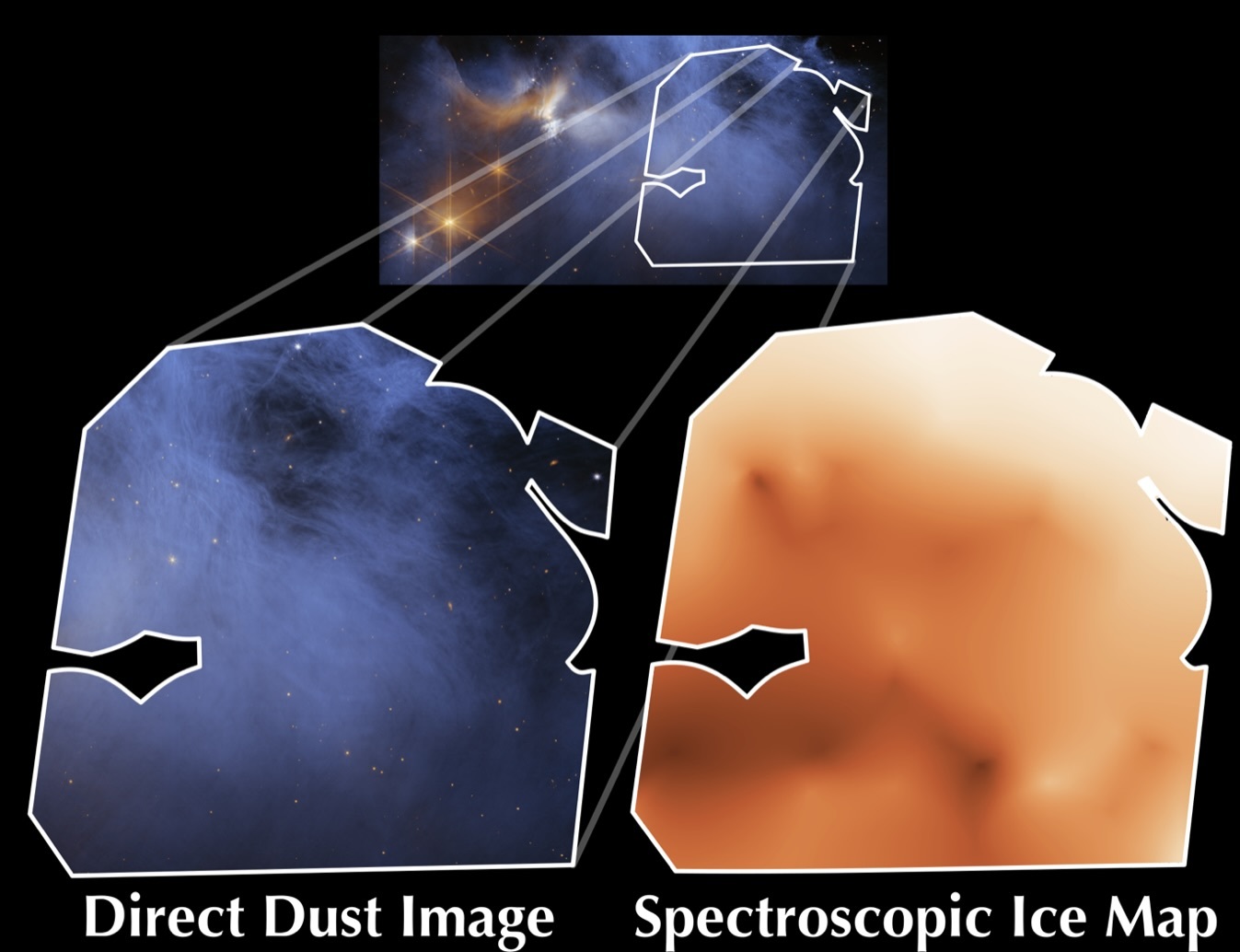Congratulations to Prof. Daniel Harsono, the latest research results published in the Nature Astronomy.
First, highly sampled ice mapping of the most abundant ices across a molecular cloud was obtained using a specialised technique with the NIRCam instrument on the JWST.
Ever since its launch, JWST observations of cold, dense regions of the galaxy have been revolutionising our understanding of how simple molecules form as interstellar ices on dust grains and continue to evolve during the star and planet formation process. So far, the JWST observations collecting spectra that contain signatures of these icy dust particles have primarily studied individual forming stars, revealing in incredible detail each forming stars’ evolved chemical and physical environment. However, to understand the initial chemical and physical environments within which these stars form and ultimately determine what quantities of these simple molecules are available to be delivered to their daughter planetary systems, it is critical to probe the chemistry of whole molecular clouds, the interstellar nurseries where stars are born. To do this, we need tens or hundreds of observations of these ices across different parts of the molecular cloud. These are obtained by measuring the light emitted by stars that are aligned with the cloud but are a great distance behind it, called background stars. This light interacts with the interstellar icy grains as it passes through the cloud before being captured by the JWST’s large mirror. These interactions create the signatures we use to discover where and how much ice is present towards each probed position of the molecular cloud. One of the main aims of the IceAge program, led by Dr. Melissa McClure from Leiden Observatory, was to demonstrate that a specialised mode on the NIRCam instrument of the JWST could be used to probe the Chamaeleon I molecular cloud at tens of positions simultaneously in a single, efficient observation. This allowed the team to build comprehensive maps of the ice chemistry across the cloud.
In the latest publication of the IceAge team (Smith et al. 2025), we present the first highly spatially sampled maps of the most abundant ice species - water, carbon dioxide, and carbon monoxide - across any molecular cloud. These ices are the key chemical precursors that will set the initial conditions for the chemistry of the protoplanetary disks that will form around new stars in these regions and, ultimately, contribute to the potential habitability of the exoplanets that may form within a disk. As such, it is critical to map how this ice chemistry changes across the region of the molecular cloud, which will collapse into the disk material. These ice maps are the first ever from JWST and were obtained using a specialised mode of the NIRCam telescope (Wide Field Slitless Spectroscopy) that required the development of a custom piece of software to extract the infrared spectral data. The mapping technique represents a step change in our ability to observe and detect ice in space, and is a novel (and currently under-exploited) use of the technical capacity, sensitivity, spatial and spectral resolution of JWST. Our technique, combining high-sensitivity infrared spectroscopy with the custom extraction method, allows us to map ices on spatial scales close to those routinely used to map gas phase chemistry in clouds with radioastronomy. We can thus probe changes in both the ice and dust, adding the missing piece of the puzzle to fully understand the chemistry of the whole cloud.

© Z.L. Smith (Leiden University/Open University), J.A. Noble (Aix Marseille Université), M.F Rashman (Open University) and the IceAge team. Image adapted from data presented in Smith et al. Nature Astronomy 2025 (doi: 10.1038/s41550-025-02511-z) and from a NIRCam image of Cha I (credit: NASA, ESA, CSA and M. Zamani (ESA/Webb); science: M.K. McClure. (Leiden University), F. Sun. (Steward Observatory), Z.L. Smith. (Leiden University/Open University) and the IceAge ERS team).
Link to the published article:
https://www.nature.com/articles/s41550-025-02511-z
Contact:
Daniel Harsono, dharsono@gapp.nthu.edu.tw
Reference:
Smith et al. ‘Cospatial ice mapping of H2O with CO2 and CO across a molecular cloud with JWST/NIRCam,’ Nature Astronomy 2025, doi: 10.1038/s41550-025-02511-z
